#On-site Diesel Engine
Explore tagged Tumblr posts
Link
On-site Diesel Engine Overhauling and Repairs adhere to a defined process that includes disassembling, cleaning maintenance, inspecting, reconditioning, and assembling the engine according to the manuals of the relevant manufacturers. For more detail email [email protected] or call +91 9582647131, tel. 124-425-1615.
#On-site Diesel Engine#On-site Diesel Engine Overhauling and Repairs#marine diesel engine repair#Engine Overhauling and Repairs#Overhaul And Maintenance Services#Marine Engine Maintenance and Repair#diesel engine repair services#onsite repair and overhauling of diesel engines#repair and overhauling of diesel engines#Overhauling and Repair Diesel Engines Services
0 notes
Text
Since in thinking of making Cats keychains. It could be fun to make stex ones too 👀
Like these tiny trains I made or redraw them since these are old now

Sorry if I'm being annoying just the thought of making physical things like keychains and pins sounds like so much fun to me!
#ive found an even better site with even more variety for charms and pins#stex#starlight express#stex fanart#ideas#rusty the steam engine#greaseball the diesel#electra the electric engine#cb the red caboose#dinah the dining car
29 notes
·
View notes
Text
Revitalize your Yanmar Diesel Engine 6N18AL-DV with our expert Onsite Crankshaft Repair services! Dive into our latest blog detailing the precision machining techniques applied to enhance the performance of your engine—experience unrivaled expertise in crankshaft restoration. Visit our page now for insights and solutions. Maximize your Yanmar engine's lifespan and efficiency—trust us for top-notch onsite repair and superior crankshaft machining. Dial +91-9582647131 or email [email protected] for more details on Yanmar crankshaft repair, and insitu machining equipment.
#On Site Crankshaft Grinding Repair#crankpin journal repair#onboard crankshaft repair#crankpin repair machine#Diesel Engine Crankshaft Repair#REPAIR OF CRANKSHAFT OF YANMAR DIESEL ENGINE#insitu machining equipment#yanmar crankshaft repair#ship crankshaft machining#Onsite Crankshaft Repair services
0 notes
Text
On site Engine Overhauling and Overhaul of Yanmar Diesel Engine
In addition to offering services for diesel engine repair, RA Power Solutions also provides engine replacement parts and performs major component repairs and onsite engine overhauling. No other business provides all the services under one roof. To get more information on onsite engine overhauling, on-site engine overhauling and overhaul of Yanmar engine then contact us today at [email protected], 0124-425-1615, or +91-9810012383.
#onsite engine overhauling#on site engine overhauling#overhaul of yanmar engine#diesel engine repair#marine diesel engine#diesel engine repair overhauling and maintenance
0 notes
Text
The flotsam and jetsam of our digital queries and transactions, the flurry of electrons flitting about, warm the medium of air. Heat is the waste product of computation, and if left unchecked, it becomes a foil to the workings of digital civilization. Heat must therefore be relentlessly abated to keep the engine of the digital thrumming in a constant state, 24 hours a day, every day. To quell this thermodynamic threat, data centers overwhelmingly rely on air conditioning, a mechanical process that refrigerates the gaseous medium of air, so that it can displace or lift perilous heat away from computers. Today, power-hungry computer room air conditioners (CRACs) or computer room air handlers (CRAHs) are staples of even the most advanced data centers. In North America, most data centers draw power from “dirty” electricity grids, especially in Virginia’s “data center alley,” the site of 70 percent of the world’s internet traffic in 2019. To cool, the Cloud burns carbon, what Jeffrey Moro calls an “elemental irony.” In most data centers today, cooling accounts for greater than 40 percent of electricity usage.
[...]
The Cloud now has a greater carbon footprint than the airline industry. A single data center can consume the equivalent electricity of 50,000 homes. At 200 terawatt hours (TWh) annually, data centers collectively devour more energy than some nation-states. Today, the electricity utilized by data centers accounts for 0.3 percent of overall carbon emissions, and if we extend our accounting to include networked devices like laptops, smartphones, and tablets, the total shifts to 2 percent of global carbon emissions. Why so much energy? Beyond cooling, the energy requirements of data centers are vast. To meet the pledge to customers that their data and cloud services will be available anytime, anywhere, data centers are designed to be hyper-redundant: If one system fails, another is ready to take its place at a moment’s notice, to prevent a disruption in user experiences. Like Tom’s air conditioners idling in a low-power state, ready to rev up when things get too hot, the data center is a Russian doll of redundancies: redundant power systems like diesel generators, redundant servers ready to take over computational processes should others become unexpectedly unavailable, and so forth. In some cases, only 6 to 12 percent of energy consumed is devoted to active computational processes. The remainder is allocated to cooling and maintaining chains upon chains of redundant fail-safes to prevent costly downtime.
521 notes
·
View notes
Text
The rail network in Germany is in so bad shape that they had to get a centenarian out of retirement. That is, a steam engine built in 1921 and retired in 1977.
But let's start at the beginning.
The rail network runs on electricity.
Sometimes when there's big time repairs being done, there can't be electricity around that spot.
To transport materials to a railway construction site without electricity, you need an engine that doesn't run on electricity, but carries its own fuel.
So you get one of the remaining diesel engines.
Unfortunately those are getting rare, and there are a lot of construction sites, so at one point a company doing construction took to contacting an organisation that keeps historic trains going for train lovers as sort of museums, and asked if they could borrow their diesel engine.
The diesel engine was not available, but the museum guys joked that they could offer a steam engine. And the construction company was so desperate they accepted.
That job went well, and people in the business were like "hey, the old girl still got it!" so the steam engine got rented for more jobs like that.
At least one time a fire brigade had to help out with upping the water supply, I guess becaue not every station is equipped to do that any more, but over all, well. She occasionally pulls freight trains instead of passenger trains full of fans of historic trains.

Sounce links - mind the article is German:
original source: https://bnn.de/karlsruhe/ettlingen/kurios-dampflok-58-311-aus-ettlingen-zieht-wieder-regulaere-gueterzuege
archive link: https://archive.ph/pQFrj#selection-739.22-739.28
157 notes
·
View notes
Text
Technology from 1870-1899 (For Encanto fic writers)
So, A mutual of mine @miracles-and-butterfliess pointed out that everyone (including me) tends to forget that Encanto was literally made when the triplets were born. Which is literally 1900 or 1901. Regardless, it was the very beginning of the 19th century so let me tell you about the technology/things they would/wouldn’t have. (And please keep in mind that most of these may or may not have been imported into Colombia yet.)
1870 - 1879
1872—A.M. Ward creates the first mail-order catalog. NO
1873—Joseph Glidden invented barbed wire. NO
1876—Alexander Graham Bell patents the telephone. NO
1876—Nicolaus August Otto invents the first practical four-stroke internal combustion engine. NO
1876—Melville Bissell patents the carpet sweeper. NO?
1878—Thomas Edison invents the cylinder phonograph (known then as the tin foil phonograph). MAYBE
1878—Eadweard Muybridge invents moving pictures. NO?
1878—Sir Joseph Wilson Swan invents the prototype for a practical electric lightbulb. YES?
1879—Thomas Edison invented the first commercially viable incandescent electric light bulb. NO?
1880 - 1889
1880—The British Perforated Paper Company debuts toilet paper. YES
1880—English inventor John Milne creates the modern seismograph. NO
1881—David Houston patents camera film in roll format. NO?
1884—Lewis Edson Waterman invents the first practical fountain pen. YES
1884—L. A. Thompson built and opened the first roller coaster in the United States at a site on Coney Island, New York. NO
1884—James Ritty invents a functional mechanical cash register. YES?
1884—Charles Parson patents the steam turbine. NO
1885—Karl Benz invented the first practical automobile powered by an internal-combustion engine. NO (even before Encanto, Alma’s town looked rural so I doubt the automobile reached them yet.)
1885—Gottlieb Daimler invented the first gas-engine motorcycle. NO
1886—John Pemberton introduces Coca-Cola. NO
1886—Gottlieb Daimler designs and builds the world's first four-wheeled automobile. NO
1887—Heinrich Hertz invents radar. NO
1887—Emile Berliner invented the gramophone. YES
1887—F.E. Muller and Adolph Fick invented the first wearable contact lenses. NO
1888—Nikola Tesla invents the alternating current motor and transformer. NO
1890 - 1899
1891—Jesse W. Reno invents the escalator. NO
1892—Rudolf Diesel invents the diesel-fueled internal combustion engine, which he patents six years later. NO
1892—Sir James Dewar invents the Dewar vacuum flask. NO
1893—W.L. Judson invents the zipper. NO (zippers didn’t become popular globally until a little bit later; buttons, ribbons/laces and whatever else were still the norm/in fashion for fastening and tying (which is still the case in some places today)
1895—Brothers Auguste and Louis Lumière invent a portable motion-picture camera that doubles as a film-processing unit and projector. The invention is called the Cinematographe and using it, the Lumières project the motion picture for an audience. NO?
1899—J.S. Thurman patents the motor-driven vacuum cleaner. NO (if you're running from being killed, the last thing you're going to bring is a vacuum cleaner)
I remember a post listing the sort of jobs there would be in Encanto but I forgot so I’ll just list the ones I know (let me know if I need to add anything.):
Seamstress/tailor
Embellisher
Field worker
Teacher (of any kind; music, dance, art, etc)
Woodworker - wood carver
Toy maker
Construction worker
Joining a Local band/ Orchestra - being apart of a choir
Carpenter
Metal worker
Jeweler (though I’m not sure if Jewelery of the diamond/gem kind is common in Encanto)
bladesmith/ knifemaker
Inventor? (Inventors should exist in Encanto by now…just one other genius besides Mirabel?)
I know some of these are very obvious but I’m just giving people options okay?
@miracles-and-butterflies you seem to know a lot more about this kind of stuff so if you have anything to add/take away or me to fix please let me know. I tried to search up “When was X invention imported into Colombia” and literally nothing of use comes up.
#camilo madrigal#bruno madrigal#mirabel madrigal#dolores madrigal#antonio madrigal#isabela madrigal#pepa madrigal#encanto 2021#encanto au#encanto fanfic
148 notes
·
View notes
Text
The Hard Hat
A Caption Tale

Kara entered the construction zone in her gray kitten heels. The cacophony of metal clanging against metal and the growling engines of machinery filled the air. She squinted against the dust that danced in the beams of the setting sun, feeling out of place amidst the hard hats and heavy boots. "Excuse me, can I help you?”
Kara turned to see a burly man in a yellow vest, a hard hat perched on top of his sweaty forehead. "I'm looking for the foreman," she called over the din. "I have an appointment."
The worker nodded, wiping his dirty hand on his even dirtier jeans before extending it to her. "That'd be me," he said with a smile that was surprisingly gentle amidst the chaos. "Jackson."
Kara took his hand firmly, feeling the calloused skin against her own. "Kara," she replied, raising her voice to be heard. "I'm here about the new office development."
“Of course ma’am. We just need you to put a hard hat on.” He grabbed one from the side of his toolbox and handed it to her. Kara smiled as she looked around the site and took notes. The air was thick with the scent of fresh concrete and diesel fumes, but she felt oddly alive amidst the chaos. She slipped the hat over her perfectly styled hair.
“Whoa looking good mama!” A whistle pierced the air, and Kara’s cheeks flushed as she spun around to face the culprit. A young worker in a tight-fitting T-shirt had stopped his hammering to leer at her. She rolled her eyes and followed Jackson’s lead as he marched over, his boots echoing with authority.
“Back to work, Tom,” Jackson bellowed, his gentle smile replaced by a stern look. The young man’s grin disappeared, and he hastily turned back to his task, mumbling an apology. Kara felt a strange mix of gratitude and annoyance—gratitude for the protection but annoyed that she had to be protected in the first place.
“Damn who’s this fine piece of ass?” Another whistle, this one closer, made Kara’s grip tighten around her notepad. She ignored it, focusing on the blueprints spread out before her on the makeshift table, her eyes scanning the lines and numbers as if they could shield her from the leers.
“You’re going to need some safety googles in this section ma’am. Can’t have you getting dust in those pretty eyes,” Jackson said, handing her a pair. Kara took them with a smile of thanks, slipping them over her face. Jackson smiled as he noticed her lips had a fuller look with wet lip gloss applied. Kara licked her lips with a confused face. “Why am I wearing lip gloss?” She thought as she followed Jackson.
“Oh mama, I’ve been a bad boy!” The lewd remark was accompanied by a wink from a worker as he strutted past. Kara’s jaw clenched, and she felt a flash of anger. She decided she would say something about it. “You are definitely deserving of a good spanking then naughty boy.” She replied her voice dripping with sensuality. The worker froze in his tracks, his eyes wide as he processed the unexpected response. A chuckle rumbled from Jackson’s chest, and the tension around them lightened.
Kara looked down in embarrassment, confused on what possessed her to talk like that. Kara felt warm as her scalp began to itch under her hard hat. Jackson grinned as he watched her scratch her head. “Are you feeling ok ma’am? Apologies about my workers, they tend to get raunchy around the fairer sex.”
Kara nodded, swallowing hard. “Yeah they probably need to release all that pent up energy with a real good time.” Jackson raised an eyebrow at her statement. “What do you mean ma’am?” Kara placed her hands on her hips and swayed to one side. “I’m talking about giving them something to enjoy.” Kara didn’t understand why she was acting so differently but she also couldn’t stop herself.
She pulled out her cell phone and played “Deli” by Ice Spice. Kara felt her body move on its own. Her hips swayed to the beat as she began to dance in the dusty construction zone. The workers stopped what they were doing, their eyes glued to her as she strutted closer to the group of men. They stared in a mix of shock and awe as she dropped her notepad and began to twerk, her pants shaking with her legs and ass. The music blared through the speakers of her phone.
Jackson put his hand in his pocket to adjust himself as he watched her dance. Kara put a hand on her hard hat as her pants morphed into fishnet stockings. They were loose as her heels grew taller and black. The blue shirt melted down her body resting on her hips and exposed her chest and bra. She smiled as she noticed more eyes were upon her. She felt so wet as she let go letting the music guide her.
Kara’s eyes rolled back as her yellow vest shrunk but her body grew. Her flat ass billowed out and began to clap as she twerked more proficiently with the music. The workers whistled and applauded as her curves increased with her skill. Jackson motioned one of the workers to hand him a chair as he sat down.
Kara slowly walked up to him and sat and grinded on him. She could feel her breasts expanding as her thighs got thicker stretching her stockings. She turned her head and could see Jackson’s face contort in approval. She turned her head forward as she felt his bulge get bigger and bigger. Kara bucked her hips wildly as Jackson grunted in glee.
Suddenly the music stopped, and Kara’s head snapped up. The workers had formed a circle around her, their expressions a mix of shock and lust. The foreman looked at her with newfound respect and desire. She felt a thrill run through her body as she realized she had the power to control the room. She slid off the chair and sauntered over to the group of men, her newly enhanced body moving with a confidence she had never felt before.
She went over to her phone and played Latto.
“Who’s Next?”

#beautification#transformation#f2f transformation#breast expansion#bimboification#ass expansion#beauty is power#slutification
110 notes
·
View notes
Note
In Wilbert's books, how would personally separate Henry and Gordon as characters?
I already wrote a Henry and Gordon post, but that was as much headcanon as analysis so I'll tackle this one too. Besides, I really like how this question acknowledges from the outset that RWS Gordon and Henry are basically the same character :D
Okay, not really, but they're awfully damn similar. (So are Thomas and Percy tbh.) I have read so much guff (mostly in my dreary dark bird site days) about how BoCo is basically a diesel Edward and it pisses me off. If you can distinguish between two of these pairs, then you can distinguish between all three, dammit.
Anyway, RWS Gordon and Henry are both pompous, self-important, classist (?), totally up their own arses tenders, sometimes breathtakingly ungrateful – but fundamentally good-hearted. They're sometimes complete assholes, but it's not like they actually try to be assholes… they just sometimes don't try all that hard not to be. But they have strong notions of fair play and loyalty and solidarity, and they try to live up to them (except on the days they don't).
And I will say from the outset that I much prefer their RWS "omggg… there's two of themmm 😐😩💀" dynamic than the weird TVS "manly man and sensitive guy… who also don't even seem that close" thing. That being said, even if you don't basically flanderize Henry into a funhouse-mirror version of his RWS self, yes I think we can describe their differences in the books:
1) Social roles. Gordon is the leader-y one of the two. This is probably because he's more conventional (see next point). But it is also possible that a lot of this is down to how their working schedules have shaped their dynamic with the rest of the fleet: Henry's Flying Kipper timetable means his working hours would overlap less with the daytime fleet and that he'd be either away or not in steam during moments where Gordon takes on a role helping other engines (Percy Runs Away, Leaves, Down the Mine). Of course we do see that when Henry is available, he acts in the same way (Super Rescue), but it is probably no coincidence that we see Gordon in this role first, and much more often.
Gordon's leadership also extends to him having Ideas, like his (half-baked) plan to run all the way to London, or his plans to force the Fat Controller's hand with a tender engine strike (not wholly successful, but still way more successful than one might have thought), or his plan for them to pay out first Edward and then Duck for respective 'betrayals'. Of course sometimes Gordon and Henry are in total lockstep without even needing to consult, with an absolutely adorable shared brain thing – like when they initially reject Diesel's idea that Duck is gossiping about them, or when they strong-arm Percy into being the deputation ("Rubbish, Percy. It's easy." "That's settled, then.") This shows how similar they are in outlook and feeling, but Henry is the more passive of the two, we have never seen him initiate… anything, I think? Gordon is the one who makes things happen, and the one that Henry and James look to for leadership within their group. I don't actually think the whole of the fleet looks to Gordon as reliably as James and Henry do to take charge of things, at least we don't have any textual evidence for that (and even James and Henry do it less and less as the series goes on). But I do suspect that he's definitely the one the rest of the fleet would look to first in a choice between him and Henry.
2) Self-esteem. I'm going to come in with a flaming hot take and say that Henry is the one of the two more confident and comfortable with himself. Henry of course does a lot of moaning, and he moped a lot in his early days, when he was physically struggling. But even in those early days he was still proud as punch, willing to flat-out reject orders from his crew and the Fat Controller; it's also striking to me that he switched from blue to green paint (conformity to individuality) before he got his Welsh coal. Henry actually has quite a strong sense of self-esteem. Gordon is arrogant, but he has every reason in the world to be. Henry could swagger around even when he didn't. Gordon has to emphasize his background and his tender engine status because he requires external markers of worth; Henry doesn't explicitly reject that stuff, but he's certainly NOT hung up on it enough to actually expound theories about it to captive tank engines ("You don't understand, little Thomas; we tender engines have a position to keep up…"). And Henry seems to have been the first to drift out of the big three engines' hive mind. He was the last to join the strike, the first to support Duck when challenged, the first to think that Bear wasn't so bad, and the least inclined to trash-talk smaller engines. Henry's an individualist, and if he doesn't try to make things happen as much as Gordon it's at least in part because he doesn't feel the need to. Of course he adores recognition and importance and respect from the others (they all do, really) but he can function without it. He's proven it. And if he's not as active as Gordon in some respects, he's also not quite so reactive. For example: although he's not the brightest bulb, I don't think he'd have ever been so thoroughly convinced that Bill and Ben were about to kill him, either.
3) Emotionality. This is strongly related to point 2 actually, but my other flaming hot take is that Gordon is a more emotional machine than Henry. Henry gets the bad rap for moaning and pissing, but I'm actually amazed, again and again, by how quickly Henry bounces back from hurts and setbacks – witness the absolute lack of drama after the horrible Flying Kipper wreck.
Gordon, in contrast, gets into his feels more quickly, and requires more external support to get on his rails again. We've never needed an entire book to describe Henry's depression after being in Disgrace.
"That's all right, Thomas. You made me laugh. I like that. I'm in disgrace," Gordon went on pathetically, "I feel very low."
I'm sorry, why did Henry get flanderized as the sopping wet cat out of the two? ;)
Henry and Gordon are contrasted again with the news of the end of steam. Henry is totally oblivious, preoccupied with some bullshit status symbols. Gordon's going through a whole-ass existential crisis.
Which, fair. That's a reasonable thing to have an existential crisis about. But we also know that Gordon is capable of catastrophizing like a mofo. He perceives lots of things as threats, and dwells on them. We're back here to "No, no, I AM Gordon! Stop, stop!" We're back to him enjoying Thomas teasing him because it's the only normal thing in his life when he's being punished for his ditch nonsense. We're back to him spending most of Gordon the High-Speed Engine moping over various slights.
This also ties back into point 1, about Gordon being perceived as a leader. I think part of that tendency is because Gordon is able to bond with other engines when they are down – when they're down, he can let down his own guard. There's empathy there ("No one understands our feelings," Gordon says to Sir Handel, winning over the smaller engine's entire heart). Henry is capable of treating other engines well too, we've seen it, but we haven't seen that evidence of empathetic feeling. Mind you, this is not a bad thing or a criticism; ethics aren't dependent on empathy. It's just an observation in their approach. Henry's connections with other engines seem to be built on a more cerebral approach, a we-stand-together-because-it's-pleasant-and-mutually-beneficial mindset. Now obviously, Mr Shall-We-Form-An-Alliance is familiar with the idea, but honestly when Gordon makes connections, it seems to be with his heart (which may be why he's far more inconsistent about it lol, and why he tends to blow hot or cold! Henry seems to be on generally good terms with everyone, after his first few books, whereas Gordon has conflicts as well as friendships that spring up very suddenly).
In addition to his "low," "pathetic" moments, "high spirits" are also more strongly marked in Gordon than in Henry. This is another facet where we see that Gordon is just more emotionally driven than Henry, although – again! – I don't think the two are very far apart. We're talking about differences in degrees, not polar opposites by any means.
#ttte#ttte analysis#chatter#ttte henry#ttte gordon#the railway series#3+4#not *quite* a character dynamic ask#but we're getting there :D#you'll notice that i haven't always written them consistently in this way#because interpretation and 'i'm driving this character now' are half the fun of fandom#but this is my best attempt to stick strictly to the rws text and not bring my own preferred notions into it
47 notes
·
View notes
Text
Traintober 2024: Day 10 - Flora
Flora and the Great Waterton Flower Show

Flora the tram engine works on a small logging tramway on the eastern side of the island of Sodor. It begins at Vicarstown before heading inland to Great Waterton, the site of a major waterworks. The line mostly transports the water from the waterworks or logs from the numerous small timber plantations that surround the little town. During harvest season, Flora would even take the produce from the farms. Her little line travelled along a road, so Flora needed cowcatchers and sideplates by law – but the road was unpaved, and so very few people liked to drive along it.
The only engines Flora really met were the few who spent time at Vicarstown. She’d made good friends with Bear the diesel and the Scottish Twins, but she avoided the big engines. They were just too pompous for the little sunshine-yellow tram.
One morning, Bear rumbled into the yard to see Flora looking even sunnier than usual! “What’s got you so excited?” asked Bear. “The Great Waterton Flower Show is on tomorrow,” beamed Flora. “And I’ve just been given a new coat of paint for the celebration!” Bear had never been to a flower show before, and thought they sounded rather silly when flowers grew everywhere already, but he decided to support his friend.
“Are you going to see it?” he asked. Flora practically whistled with glee. “They’re holding it at the station!” she exclaimed. “And I’m even going to be decorated! I’m going pull so many passengers in Moseley.” Moseley – Flora’s sleepy tram coach – stirred at the mention of his name, opening a bleary eye. He was getting cleaned for the celebration, and there was a workman polishing his stair railing.
“See, he’s so excited!” chirped Flora. Bear wasn’t sure what was different about Moseley to hint at excitement, but was happy for his friend anyway.
Flora was so excited that she could barely sleep – but sleep she did, much to her shedmates’ thankfulness – and soon she was being steamed up for her first trip so the Great Waterton Flower Show.
Gordon met her at the platform with a train of his own. Passengers flooded from his coaches to swarm Moseley, who was quite stunned at the turn of events! “I can’t hold this many!” he spluttered. Flora chuckled and went to fetch a couple spare coaches from the carriage sidings. When she returned, she found Gordon staring at her consideringly.
“So you must be Flora,” he said. “I am surprised we have not met properly before.” “Ah, well I am busy,” Flora replied, not wanting to admit that she avoided him. “Well,” hummed Gordon, “that’s alright. Though I do think it mustn’t be that important – you’re tucked away on your little insignificant branchline, after all.” Flora glared, but just trundled away with her heavy train of passengers. She didn’t want Gordon’s dismissiveness to spoil her day.
The flower show was stunning! The various gardens were spotless, with flowers in all shades of the rainbow. Some were tropical, and had special sun lamps to keep them warm and snug while others were from the furthest winters, and were in special pots that kept the soil cool for them. Flora was in love! She spoke to every gardener who would listen, and her driver managed to get a couple to agree to redo the flower boxes at Vicarstown sheds.
Then, Flora went to pick up the special guest. She wasn’t sure who it was, but considering how nervous the mainland diesel looked when he slowed to a stop it was someone very important. Flora had even been given a special, ultra-luxurious coach for the guest, and there was a red carpet!
Then, the guest stepped out and Flora couldn’t hold in her stunned gasp. It was the Queen! “I’m about to pull Her Majesty!” hissed Flora in astonishment. “But I thought the Queen only went to the Chelsea Flower Show?” “She’s come to judge some of the gardens apparently,” her driver replied, equally as stunned. “Let’s give her a grand ride.”
Flora was extra careful as she made her way down her little tramway, wincing at every little bump she felt in the rails. As much as her little line was beautiful, it was also not meant for such important passengers. Flora hoped the Queen was enjoying the scenery more than the track!
When they arrived, there was a great reception waiting! The mayor and the local councillor and all the guests, contestants and locals were waiting for Her Majesty, and had prepared a special high tea for her. But instead of following the mayor, the Queen turned and made her way up to where Flora was standing.
“Thank you very much for a smooth ride,” the Queen said. “You are perhaps the brightest and most cheerful little tram I have ever met. Do you enjoy flowers too?” “Y-y-yes, Your Majesty,” gulped Flora. The Queen chuckled. “There’s no need to be nervous,” the Queen said kindly. “I just noticed your nameplate – were you inspired by the flowers, by any chance?” “I was,” admitted Flora. “I really like daffodils.” “I do too,” replied the Queen, and for the first time, Flora got a chance to see Her Majesty’s outfit – it was the same shade of yellow as her! The Queen waved to someone, and they walked over. It was a photographer. “Would you take a photo of us?” she asked. Flora blushed bright red! “With me!” she squeaked.
The Queen just nodded. The pair posed for the photographer, and then the Queen turned to Flora one last time.
“I hope you also enjoy the flower show today.” And with that, the Queen headed off for her special tea. Flora felt faint. The rest of the day seemed to just flash by, and all too soon she was backing into the sheds. Both Gordon and Bear were there.
“How was your little flower show?” asked Gordon, smirking at the little tram. “Fabulous!” grinned Flora. "I heard you had a special visitor," said Bear, looking excited. "Who?" snorted Gordon. "Aslan of Narnia?!" Flora was about to retort when her driver ran over. “Someone’s here to see you again!” he exclaimed excitedly. He nodded his head, and all three engines looked over. Gordon’s eyes widened to the size of serving platters as he spotted The Queen stepping over the rails towards the shed.
“Your Majesty?!” he spluttered. “What an honour!” “Indeed,” replied the Queen. “It is an honour for me to present Flora with a special award: the RHS President’s Award for Best Flora.” She pulled out a large medal and placed it on Flora’s lampiron. Flora was beside herself with excitement! “I also wanted to personally thank you again for such a smooth ride today – your little line is absolutely stunning, Flora, and I wish you many more successful years.” She turned. “As for you, Gordon – well, maybe next year.”
And with that, the Queen strode away, leaving behind a speechless Gordon, a cackling Bear and one very proud Flora!
Back to the Master Post
#weirdowithaquill#fanfiction writer#railway series#thomas the tank engine#railways#traintober#traintober 2024#ttte flora#ttte bear#ttte gordon#queen elizabeth ii#Great Waterton#flower show#prompt: flora
18 notes
·
View notes
Text
Gas Station Stream of Consciousness Post
Gas Stations as Liminal Spaces
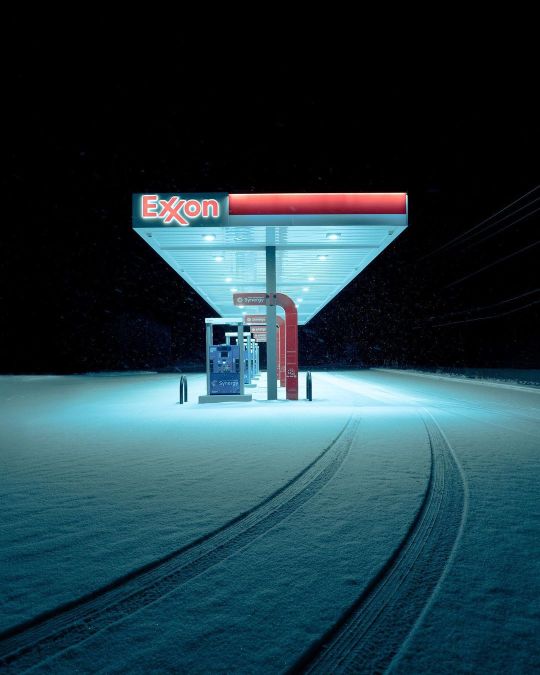
I've had quite a few hyperfixations in my day - ATMs, laundry detergents, credit cards - so my current one pertaining to gas stations is fitting considering my affinity for liminal spaces and the dedication of this blog to them. Liminal spaces are transitory in nature, hence their portrayal in online circles through photos of carpeted hallways, illuminated stairwells, dark roads, and backrooms, among other transitional points.

Gas stations are posted online as well; images of their fuel pumps or neon signage photographed through a rainy car window communicate their liminality and the universal experiences they provide to all of society. Perhaps they are the ultimate specimen of a liminal space. The machines they are created for, automobiles and tractor trailers alike, themselves are tools for motion, vestibules that enable travel and shipment across long distances at high speeds. Cars and roads are liminal spaces, albeit in different formats, and gas stations serve as their lighthouses. Vehicles at filling stations, therefore, are in a sense liminal spaces within liminal spaces within liminal spaces.
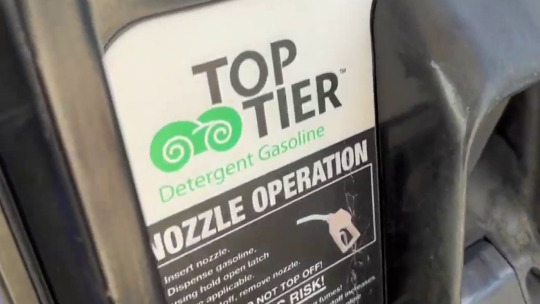
The uniqueness of a gas station as a liminal space, however, is its intersection with the economics and aesthetics of capitalism. Gasoline (and diesel fuel) is a commodity, downstream from crude oil, merely differentiated by octane ratings. Some argue that minute distinctions between agents, detergents, and additives make some brands better than others. Indeed, fuels that are approved by the Top Tier program, sponsored by automakers, have been shown to improve engine cleanliness and performance, but this classification does not prefer specific refiners over others; it is simply a standard. To a consumer, Top Tier fuels are themselves still interchangeable commodities within the wider gasoline commodity market.
The Economics of Gas Stations

The market that gas stations serve is characterized by inelastic demand, with customers who reckon with prices that fluctuate day in and day out. This is not to say that consumer behavior does not change with fuel prices. It has been observed that as prices rise, consumers are more eager to find the cheapest gas, but when prices fall, drivers are less selective with where they pump and are just happy to fill up at a lower price than last week. In response, gas stations lower their prices at a slower rate than when increasing prices, allowing for higher profit margins when wholesale prices fall. This has been dubbed the "rockets and feathers" phenomenon.

When portrayed as liminal spaces, gas stations are most often depicted at night, places of solitude where one may also enter the adjacent convenience store and encounter a fellow individual who isn't asleep, the modern day lightkeeper. The mart that resides at the backcourt of a gas station is known to sell goods at higher prices than a supermarket, simultaneously taking advantage of a captive customer, convenient location, and making up for the inefficiencies of a smaller operation. It may come as no surprise, then, that gas stations barely make any money from fuel sales and earn their bulk through C-store sales. This is a gripe I have with our economic system. Business is gamified, and in many cases the trade of certain goods and services, called loss leaders, is not an independent operation and is subsidized by the success of another division of a business, a strategy inherently more feasible for larger companies that have greater scale to execute it.
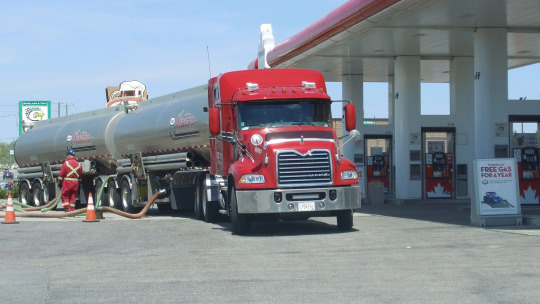
Nevertheless, most gas station owners, whether they have just one or hundreds of sites, find this method fruitful. Even though most gas stations in the US sell one of a handful of national brands, they operate on a branded reseller, or dealer, model, with oil companies themselves generally not taking part in the operations of stations that sell their fuels. The giants do still often have the most leverage and margin in the business, with the ability to set the wholesale price for the distributor, which sells at a markup to the station owner, which in turn will normally make the least profit in the chain when selling to the end customer at the pump. This kind of horizontal integration that involves many parties lacks the synergies and efficiencies of vertical integration that are so applauded by capitalists, but ends up being the most profitable for firms like ExxonMobil, who only extract and refine oil, and on the other end of the chain merely license their recognizable brands to the resellers through purchasing agreements. Furthermore, in recent years, independent dealers have sold their businesses to larger branded resellers, in many cases the ones from whom they had been buying their fuel.
A Word on ExxonMobil's Branding Potential
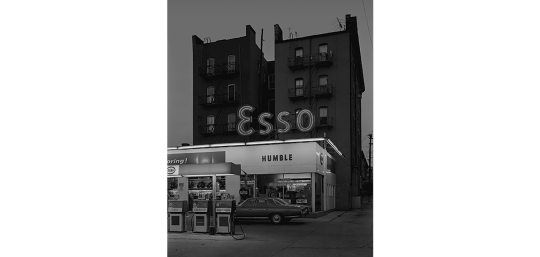
The largest publicly traded oil company in the world is Exxon Mobil Corporation. It is a direct descendent of the Rockefeller monopoly, Standard Oil, which was broken up in 1911 into 34 companies, the largest of which was Jersey Standard, which became Exxon in 1973. This title was generated by a computer as the most appealing replacement name to be used nationwide to unify the Humble, Enco, and Esso brands, decades before AI was spoken of. The latter brand is still used outside of the United States for marketing, arising from the phonetic pronunciation of the initials of Standard Oil. In 1999, Exxon and Mobil merged, and the combined company to this day markets under separate brands. Exxon is more narrowly used, to brand fuel in the United States, while Mobil has remained a motor oil and industrial lubricant brand, as well as a fuel brand in multiple countries.

Mobil originated in 1866 as the Vacuum Oil Company, which first used the current brand name for Mobiloil, and later Mobilgas and Mobilubricant products, with the prefix simply short for "automobile". Over time, Mobil became the corporation's primary identity, with its official name change to Mobil Oil Corporation taking place in 1966. Its updated wordmark with a signature red O was designed by the agency Chermayeff & Geismar, and the company's image for service stations was conceived by architect Eliot Noyes. New gas stations featured distinctive circular canopies over the pumps, and the company's recognizable pegasus logo was prominently on display for motorists.

I take issue with the deyassification of the brand's image over time. As costs were cut and uniformity took over, rectangular canopies were constructed in place of the special ones designed by Noyes that resembled large mushrooms. The pegasus remained a prominent brand icon, but the Mobil wordmark took precedence, which I personally believe to be an error in judgement. This disregard for the pegasus paved the way for its complete erasure in 2016 with the introduction of ExxonMobil's "Synergy" brand for its fuel. The mythical creature is now much smaller and appears only at the top right corner of pumps at Mobil gas stations, if at all.

Even into the 90s and the 21st century the Pegasus had its place in Mobil's marketing. In 1997, the company introduced its Speedpass keytag, which was revolutionary for its time and used RFID technology, akin to mobile payments today, to allow drivers to get gas without entering the store or swiping a card. When a Speedpass would be successfully processed, the pegasus on the gas pump would light up red.

When Exxon and Mobil merged in 1999, the former adopted the payment method too, with Exxon's less iconic tiger in place of the pegasus.

The program was discontinued in 2019 in favor of ExxonMobil's app, which is more secure since it processes payments through the internet rather than at the pump.
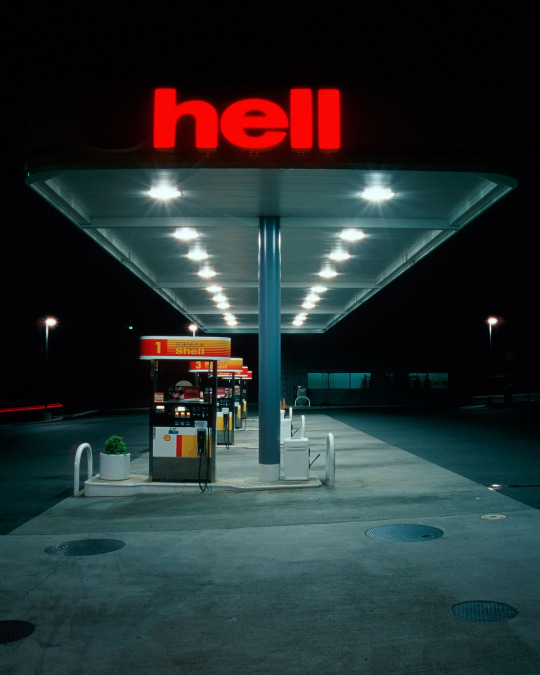
What Shell has done with its brand identity is what Mobil should've done for itself. The European company's logo was designed in 1969 by Raymond Loewy, and is a worth contender for the "And Yet a Trace of the True Self Exists in the False Self" meme. In recent years, Shell went all in on its graphic, while Mobil's pegasus flew away. I choose to believe that the company chose to rebrand its stations in order to prevent the malfunction in the above image from happening.

ExxonMobil should have also discontinued the use of the less storied Exxon brand altogether, and simplifying its consumer-facing identity to just the global Mobil mark. Whatever, neither of the names are actual words. As a bonus, here is a Google map I put together of all 62 gas stations in Springfield, MA. This is my idea of fun. Thanks for reading to the end!
#exxonmobil#exxon#mobil#gas station#gas stations#liminal space#liminal spaces#liminal#liminalcore#liminal aesthetic#justice for pegasus#shell#corporations#capitalism#branding#marketing#standard oil#economics#gas#gasoline#fuel#oil companies
107 notes
·
View notes
Text

1930 Queen of the South - Jim Jordan
Southern Railway’s green and gold PS-4’s, “First Ladies of the Pacific,” were created in the classic tradition of standard railroading between the 1920s and the 1930s. SR’s then President Fairfax Harrison was vacationing in England in 1925 and admired the brilliantly styled designs of green with gold leaf trimming on the London and North Eastern engines. He set about immediately on his return to use a similar color scheme on these new engines. The appearance of the PS-4’s on the AGS lines (Alabama Great Southern) in the south drew great crowds and netted the SR overwhelmingly favorable publicity. The beautifully decked out Queen and Crescent engine – 6689 made her first run in May, 1929 from Cincinnati through Chattanooga, Birmingham, Meridian, and on into New Orleans. Being the typical passenger locomotive she was equipped with all of the Southern’s needs – the ability to pull up to 14 cars with a top speed of 80 miles an hour, and 80,000 miles between overhauls.
The decade between 1928 – 1938 saw the first lady PS-4′ in their glorious, most fashionable years, racing up and down the lines from Washington to New Orleans. But by the early 1940’s with the inevitable competition of diesel power, the “Ladies of the Pacific” were seeing their reign o’er the rails coming to a close. Yet shortly, the PS-4’s were about to make one last comeback. Ironically, it took a world war to extend their reign of glory. The “Queen” and others were called upon for the unprecedented passenger train miles needed for troop movement. Heavy travel made it imperative that steam – the old faithful mode of transport – be kept working to the limits of its availability.
FURNACES
The Sloss Furnaces were built in the 1880’s in Birmingham – the chief center for coal and iron in the southeastern United States. For some ninety years, Sloss was an operating industrial site. Closed in 1971 – unable to comply with pollution standards – it became a National Historic Landmark where concerts at Birmingham are coordinating archaeological and preservation work on site. Volunteers are needed to keep the machinery and grounds in top condition for future generations.
Paralleling the Norfolk Southern railroad tracks, the Sloss’ silhouette looms silently, yet oddly majestic in the Birmingham sky – just another reminder of an era quietly passing, like the stately ladies of steam.
13 notes
·
View notes
Text
[American Gods]
The FreeWhale
[inbetween forkfuls of roadside diner hashbrowns smothered in Tabasco sauce and gulps of black coffee with 6 sugars to a cup]
I was doing a late-night jaunt west down the I-10, planning to take the 15 up to Las Vegas to drop some cargo, when I saw this light on the horizon.
Now that in itself isn’t unusual. Construction site, football game, poorly managed corporate parking lot; lots of reasons to see lights at night.
But this light, it blazed. It was too crisp, too close, too dense. It shone whiter than daylight and cast shadows sharp as knives. And as I drew closer I realized that the source of the light was on the freeway itself.
Now I will freely admit that my vocabulary is not the most expansive, but I don’t know if we have a word in English for the thing that cast that light. Machinery is technically correct, but…
Countless wheels it had, with more axles than I got to count and more tires per axle than I’ve seen before or since. 2 double-wide trailers side-by-side, commanding 4 lanes in all, as long as a football field and lit up twice as bright. Carried aloft and suspended between them by a web of hard steel chains was a great and weighty throne, bearing a golden statue of a blood soaked man, flat goggled eyes expressionlessly overseeing the endless road.
Hauled by a team of engines, 16 in all, 4 to a lane and 4 abreast, lashed together like sled dogs of old, billowing clouds of black diesel and blood smoke. Somehow, over the cacophony of wind and motor, I heard the distant screams of the Blood Sacrifice which powered the God Of The Freeway, the bodies of men and women young and old crushed into paste by the ruthless intersection of momentum and inattention in a thousand car accidents each day.
I saw men in high-vis and boot, clambering about the great mechanism like ants upon a tree, adjusting the tension of the chains and the power of the motors, bearing this colossi of weighty momentum and terrible speed along the endless night highways to a destination that would never arrive.
I knew with a sudden terrible clarity that if I remained too near that my own engine would be lashed into service; that the heraldry upon the engines bore the names of defunct shipping companies and dead independent drivers; and that the dreadful velocity of the God Of Freeways would carry it ever westward, far ahead of a sunrise that could never catch it, and so in pursuit of my own life and dawns to come I slowed, and let the God Of Freeways slip over the horizon.
#troglodyte thoughts#free range sustainable shitpost#freeways#American gods#I saw on the highway two vast and trunk less legs of stone#look upon my works ye mighty and despair
11 notes
·
View notes
Text
The Montech water slope

At around the same time as the "Inclined Plane" of Saint-Louis-Arzviller, other types of boat lifts were being engineered in other places. One of these was the Montech water slope, situated in Southern France on the Canal Parallel to the Garonne (Canal Latéral à la Garonne), the canal from Toulouse to Bordeaux which most people would probably refer to as the Canal du Midi - a better-known term though strictly speaking, the Canal du Midi is only the section from Toulouse to the Mediterranean.

From what I can garner, the two-headed vehicle used on this slope is a conjoining of two Diesel railcars built by Soulé in the early 70s, running on tyres and featuring a daunting-looking shield. This shield would be lowered behind a boat, and the machine would travel up and down the slope, carrying along the boat and the water it bathed in!
However, the performance of this system is less impressive than the Inclined Plane. It bypasses 5 locks, and saves 45 minutes of travel time. That's not nothing, but if you arrived at an end and just missed the train, then going straight to the locks wasn't going to be much longer than waiting for the next one. Also, far more power is required to make this work (I'm reading 1000 hp motors, versus 125 hp for the Inclined Plane), and it's Diesel.
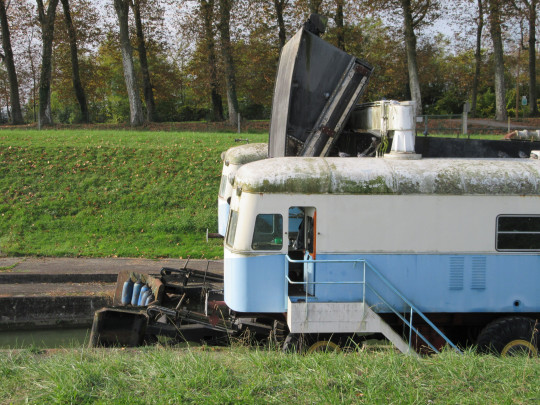
These photos were taken in late 2017, 8 years after the water slope closed. It was only serving leisure boats by then, and, as I've insinuated, it wasn't very economical to run. As far as I can tell, the 5 locks beside it never closed, and are in use today.
The slope and its tractor have since been renovated, and the site's current state can be seen in a Tim Traveller video published in 2021.
#France#Occitanie#Montech#Canal Latéral à la Garonne#Pente d'Eau#train#train-derived at least#2017-11
7 notes
·
View notes
Note
If you were making that list, what would you consider the seven wonders of the railroad world?
Hm, putting me on the spot here!
I mentioned Horseshoe Curve in Altoona, PA for a reason.
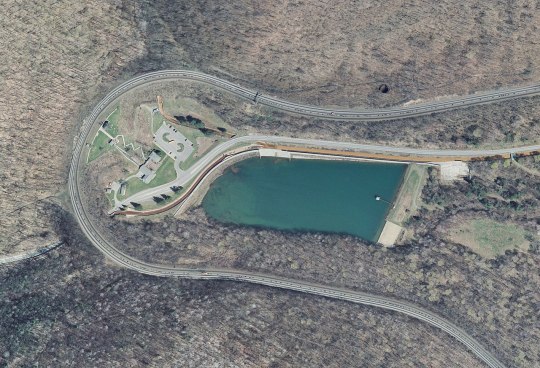
Horseshoe Curve was completed in 1854. The purpose of it was to reduce the grade trains had to climb up through the mountains and avoid the much more time-consuming route of the Allegheny Portage Railroad. Today, there's a visitor center in the middle of the Curve, and railfans go there to watch trains go by and picnic outside.
As mentioned in the previous post, Tehachapi Loop is also impressive and I'd give it a spot - it legitimately looks like something out of someone's model train layout.

From above this doesn't even look real. But it's real!
I've seen some people put the Darjeeling Himalayan Railway in West Bengal on their lists, and I'd agree with them. It's a UNESCO World Heritage Site for a reason. It's narrow gauge, climbs up through the mountains, and is popular with tourists - and although it has some diesels it also still uses steam. Look at how cute this locomotive is.
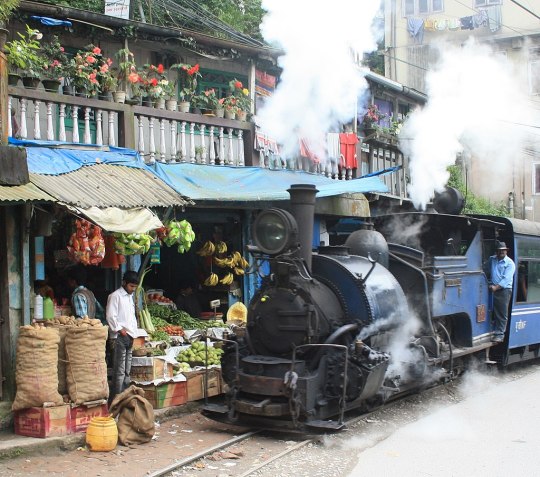
Another UNESCO World Heritage Site for consideration is the Forth Bridge, in Scotland:
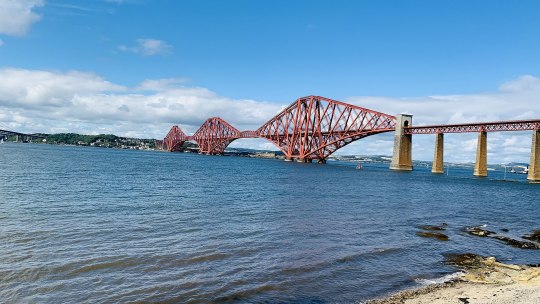
It's a cantilever railway bridge and was the longest cantilever bridge span in the world at the time of its opening, a title it held between 1890 and 1919. It's still the second longest today. In 2016 Scotland voted it as their greatest man-made wonder, an impressive feat in a country stereotyped as being chock full of civil and mechanical engineers.
For reaching incredible heights in the 19th century, look no further than the Ferrovías Central in Peru.
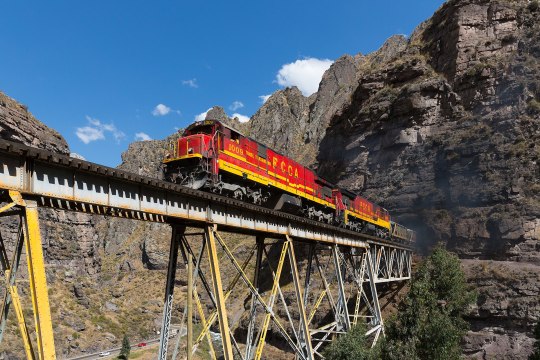
Designed by a Polish political exile named Ernest Malinowski, it was built in the 1870s and still operates today. What was known as the Callao, Lima & Oroya Railway at the time of its opening is still the second highest railroad in the world today, only being surpassed by the Qinghai-Tibet Railway over 100 years later.
It would be silly not to include the Trans-Siberian Railroad on this list - in terms of sheer scope, this thing is massive.

It's the longest railway line in the world. Nothing else even comes remotely close. Trips along it can take weeks depending on the speed the trains are running.
Lastly, for a more modern entry, I'd propose the Channel Tunnel linking England and France - at its lowest point, it's 246 feet below sea level. In terms of a modern feat of engineering, this one is definitely up there. It was completed the year I turned five, and it was a big deal even over here in the US.

Of course, the fun of this is coming up with your own! And I had to think pretty hard about this because I was trying to do it without using any locomotives, which would have been a cop-out!
Here are a few links to people having this debate online, in case you want to read more - 1, 2, 3, 4
22 notes
·
View notes
Text
🌟 Unleash Unstoppable Power with the PS POWER Diesel Generator! 🌟
Looking for a reliable, efficient, and durable power solution? Look no further! The PS POWER Diesel Generator is here to meet all your energy needs, whether for your home, business, or industrial site.
Why Choose PS POWER Diesel Generators?
🔋 High Performance: Our diesel generators are powered by top-of-the-line engines, ensuring consistent and robust power output, even under the heaviest loads.
💰 Fuel Efficiency: Say goodbye to skyrocketing fuel costs! The PS POWER Diesel Generator is designed for optimal fuel consumption, giving you maximum power with minimal expense.
🏗️ Built to Last: With a rugged, corrosion-resistant design, this generator is engineered to withstand the toughest conditions, ensuring reliable performance year after year.
🔇 Whisper-Quiet Operation: Don’t let noise disrupt your environment. Our advanced noise-reduction technology ensures quiet operation, perfect for both urban and remote settings.
🛡️ Safety First: Equipped with comprehensive safety features like automatic shutdown and overload protection, you can trust the PS POWER Diesel Generator to keep you and your equipment safe.
🌍 Eco-Friendly: Committed to protecting our planet, our generators meet stringent environmental standards, minimizing emissions while maximizing efficiency.
Perfect for: 🏠 Home Backup: Keep your household powered during outages. 🏢 Business Continuity: Ensure your operations never skip a beat. 🏗️ Industrial Use: Power heavy machinery with confidence. 🌲 Off-Grid Living: Enjoy reliable power, no matter where you are. More...

2 notes
·
View notes